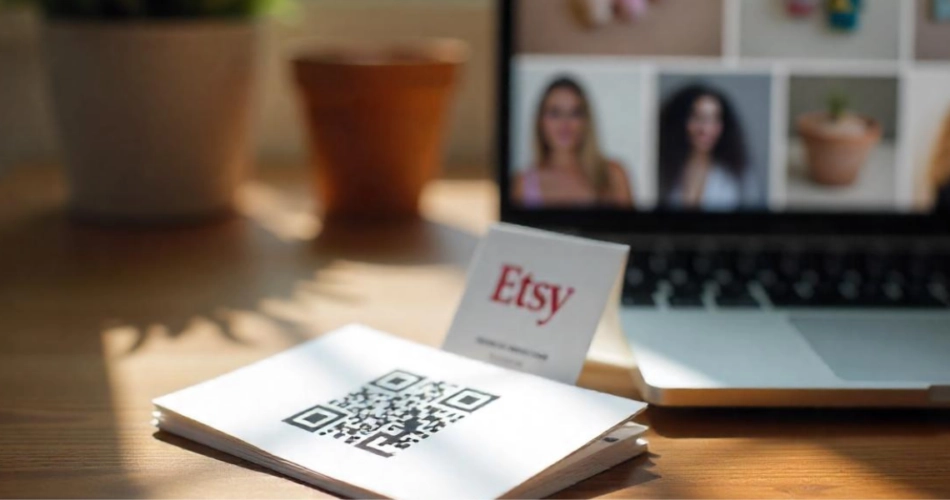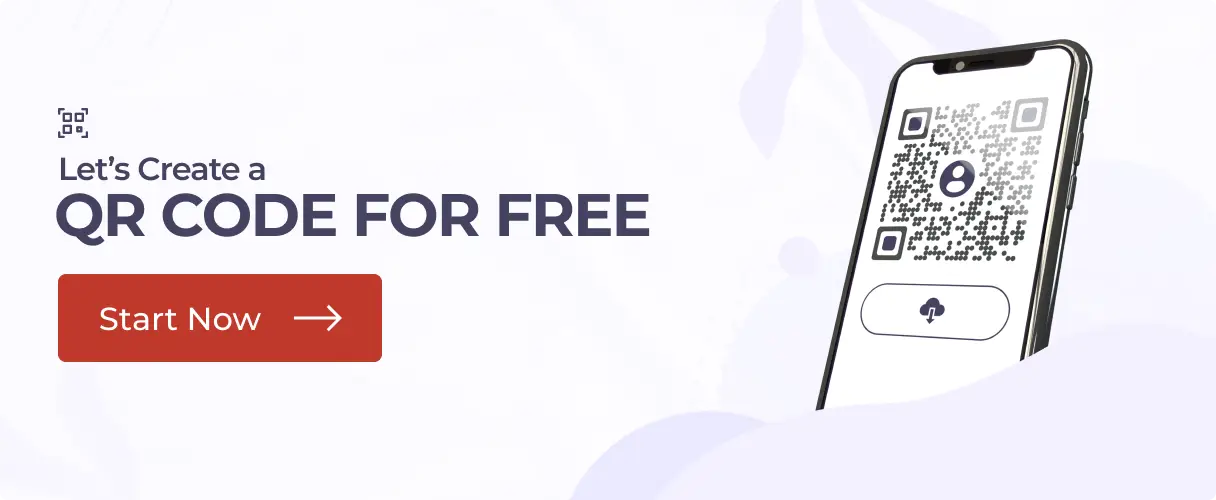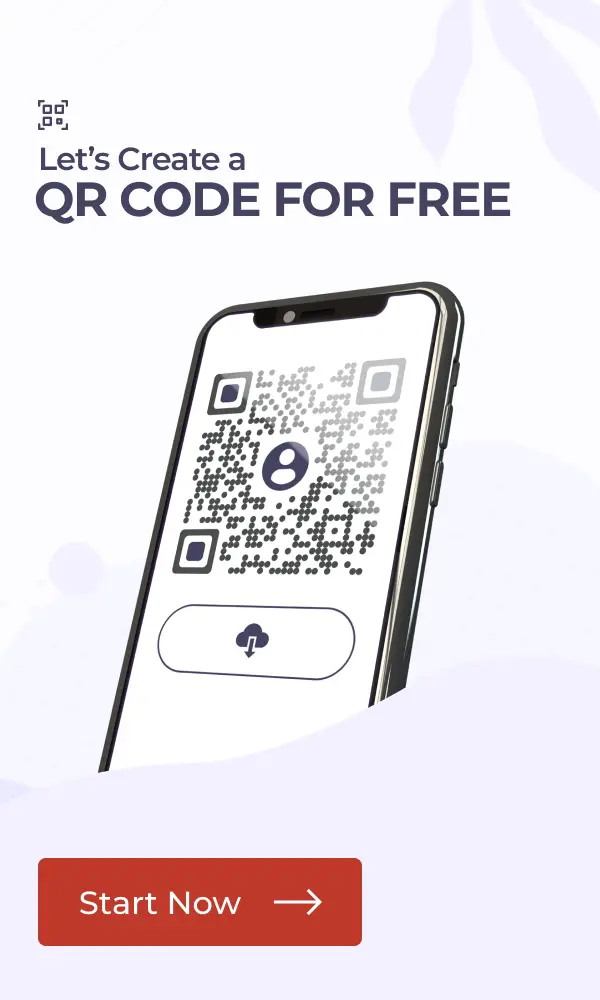Running an Etsy shop? Then you know the struggle: getting more eyes on your store, boosting sales, and keeping customers engaged.
Enter Etsy QR Codes—your secret weapon for seamless shopping. A quick scan lets Buyers jump to your store, product listings, or exclusive discounts.
There is no typing, no friction, just instant access.
In this guide, we’ll explain how Etsy QR Codes work, why they’re a must-have, and how you can use them to grow your shop effortlessly.
Let’s dive in.
A. What is an Etsy QR Code
An Etsy QR Code is a scannable code that links directly to your Etsy shop, product listings, or promotions.
Instead of making customers search for your store manually, a QR Code provides instant access with a quick scan using their smartphone camera.
You can use it on business cards, packaging, craft fair booths, social media, or printed receipts to drive more traffic and sales.
Etsy sellers leverage QR Codes to enhance customer experience, simplify reorders, and promote special deals—effortlessly turning offline interactions into online conversions.
B. How to create an Etsy QR Code
1. Go to Scanova
2. Choose the type of QR Code you want on the page that loads. Choosing the type of QR Code would depend on what you would like your QR Code to link
Do you want it to be a URL, image, or interactive video? Scanova leaves it up to you to choose your preferred category by offering many options
3. Fill in your details. We will use a Website URL QR Code. Paste your Etsy link and click “Continue”
4. Then, on the next page, give your QR Code a catchy name or something you can remember it by, and then click “Create QR Code”
5. You get a preview of your QR Code. Now, this is where magic happens! You can now edit it by choosing “Edit Design“
6. Click “Edit Design” and let your creativity roam free! You will see all the recommended designs once you click on them. This option lets you change the look of your QR Code
Let’s check out how to customize your QR Codes according to your use case. Scanova requires you to sign up for a free trial of their paid plans to use customization options. Check out the pricing details here.
I. Add a unique logo for a personal touch
The best way to do this is to include your business or occasion’s logo in the QR Code to reinforce branding.
You can access the “Custom Logo Design” option to upload your logo in PNG, JPG, or JPEG formats.
Do you prefer text? You can create a text-based logo directly.
You can resize your logo, add a stroke for better visibility, or remove data modules for a creative twist.
A branded logo ensures your QR Code connects to your business/aesthetics and builds user trust.
II. Choose colors and patterns that match your theme
Make your QR Code visually appealing by aligning it with your brand’s theme or event colors.
You can use the “Continue Editing” option to adjust the colors of the “Eyes” and data modules.
You can even add gradients for a modern, sleek effect that catches the eye. The “Eyes” tab also allows you to customize patterns, making the QR Code even more attractive.
This feature ensures your QR Code blends seamlessly into your designs, gift cards, or resume.
III. Opt for transparency (optional)
Many users make the QR Code’s background transparent for a clean, seamless look.
The “Make Transparent” option in the Background tab allows your QR Code to blend naturally with flyers, posters, or digital screens.
This approach is ideal for creating a polished and professional design.
IV. Explore different shapes and borders
You can go beyond the standard square QR Code to make it unique. Use the “Suggested” or “All” tabs from the Frames option to select shapes and borders that suit your design.
Rounded corners, creative borders, or custom shapes can add flair to your QR Code and attract more scans.
These features make your QR Code a centerpiece of your promotional materials, ensuring it stands out while aligning with your brand identity.
Once you are done with that, follow the next step to download your high-resolution QR Code:
7. Test your QR Code for perfect scans using various devices and scanners before downloading. You would not like this masterpiece lost in the sea!
8. Click that fabulous “Download” button, and your QR Code is ready.
9. When you click download, you then get to choose what format you’d like best suited for your needs, say PNG or JPG
10. Click on “Export.” Your Etsy QR Code is now ready for
C. Why Etsy sellers should use QR Codes
Customer retention, engagement, and visibility are critical components of success for Etsy vendors.
Getting customers to return to your store or learn about your newest offerings isn’t always straightforward.
QR Codes make it possible to simplify offline encounters into instantaneous online actions.
QR Codes simplify connecting with customers, whether you’re marketing your store, sending orders, or selling at a craft show.
1. Give instant access to your Etsy shop
Nobody likes typing lengthy URLs or looking for a hidden store name among rivals. Customers can scan a QR Code to be taken to your product page, Etsy store, or special offer.
This smooth experience reduces needless drop-offs and boosts conversions.
2. Boost sales & repeat purchases
Reordering is made simple for previous clients by QR Codes. Including one on your thank-you note or product package guarantees that customers can reach your store easily.
A QR Code on a sign or leaflet allows customers to peruse your offerings at craft fairs or pop-up markets, even if they decide not to buy immediately.
3. Promote discounts & exclusive deals
Doesn’t everybody enjoy a good deal? Customers are encouraged to scan and shop by using QR Codes to share special coupons or temporary savings.
To increase interaction and urgency, these codes can be printed on social media posts, product inserts, and receipts.
4. Simplify customer support & product info
Have product care instructions, order tracking information, or frequently asked questions?
Reduce friction and improve the post-purchase experience by linking a QR Code to a support page rather than continuously responding to the same consumer questions.
Positive evaluations and repeat business are more likely to come from satisfied customers.
5. Enhance social media growth
Customers interact with your brand in other places besides your Etsy store. By sending them to your Instagram, Pinterest, or TikTok, QR Codes can help you expand your social media following.
Improved brand exposure, more trust, and eventually higher sales are all effects of increased interaction.
Etsy ended Q2 2024 with $1.1 billion in cash, cash equivalents, and investments. Source: analyzify
D. Where to place your Etsy QR Code for maximum impact
The positioning of a QR Code determines how successful it is. Place it where people naturally interact with your brand, both online and offline, to receive the most scans.
Here’s where Etsy sellers may use QR Codes to increase conversions and visibility.
1. Product packaging & inserts
You have the chance to get repeat business with each order you dispatch. Include a QR Code on your thank-you notes, care instructions, or packaging.
Consumers can leave a review, follow you on social media, or scan it to place another order. Engagement can be increased by a modest reward, such as a discount on their subsequent purchases.
2. Craft fairs & pop-up markets
Not every shopper is ready to buy immediately, although they may do so later. Place a QR Code on your booth signage, price tags, or business cards to help attendees reach your Etsy shop after the event.
It’s also great for making digital payments by linking to Venmo, PayPal, or Etsy checkout pages.
3. Business cards & flyers
A QR Code on your business card transforms it into more than contact information—it becomes a direct link to your store.
Distribute them at networking events, include them in packaging, or leave them at local boutiques that promote handmade goods.
4. Social media & email signatures
Cross-promote your Etsy shop by including a QR Code in your Instagram bio, Pinterest postings, or email signature.
Customers who engage with you on one platform can find your Etsy store without searching.
5. Product tags & labels
QR Codes on product tags allow consumers to learn more about handmade or customized goods, view similar listings, and even request custom versions.
This is highly effective for fashion, home decor, and accessories.
6. Event banners & storefronts
If you have a physical shop or attend large events, a QR Code on a banner or window sign allows visitors to browse your Etsy store even if they don’t walk in.
It is ideal for always catching interest, even when your business is closed.
What our customers say about us:
E. Best practices: QR Code for Etsy shop
A QR Code is a powerful tool, but only if used correctly. To maximize scans, engagement, and sales, follow these best practices:
1. Make it easy to scan
Your QR Code should be large enough to scan from a comfortable distance. A size of at least 1 x 1 inch (2.5 x 2.5 cm) works for most printed materials, but larger is better for signage. Test it yourself to ensure smooth scanning.
2. Use a high-contrast design
Always place your QR Code on a contrasting background for the best readability. Dark codes on light backgrounds (or vice versa) work best. Avoid placing it over busy patterns or images that interfere with scanning.
3. Link to the right page
Sending customers to your Etsy homepage is fine, but linking directly to a product, special discount, or review page increases conversions. Choose the destination based on your marketing goal.
4. Include a clear call-to-action (CTA)
A QR Code alone won’t drive engagement—tell people why they should scan it. Use CTAs like:
✔ “Scan to shop our latest collection”
✔ “Get 10% off—scan here”
✔ “Leave a review—just scan!”
5. Brand it for better recognition
Make your QR Code part of your brand. Many QR Code generators allow you to add your logo, change colors, or customize the design. A branded code builds trust and looks more professional.
6. Test before printing
Always test your QR Code on multiple devices before printing or publishing it. Ensure it leads to the correct link and loads quickly on Android and iPhone cameras.
7. Track and optimize
Use a dynamic QR Code (instead of a static one). This allows you to track scan analytics and change the link later if needed. Understanding how many people scan your code can help refine your strategy.
97% of Etsy sellers run their shops from their homes. Source: analyzify
F. Common mistakes to avoid: Etsy shop QR Code
QR Codes are a valuable tool for Etsy merchants, but if not handled properly, they can be overlooked.
Here’s what to avoid when using QR Codes in your Etsy shop.
1. Printing it without testing first
Imagine printing 500 business cards to discover your QR Code does not work. Always test it on various devices and QR scanner apps before printing materials.
2. Sending customers to a generic page
If a buyer scans your QR Code expecting a discount but instead goes on your homepage, they are likely to leave. Directly link to the most relevant page, which could be a product listing, a sale page, or a review form.
3. Not customizing the QR Code
A simple black-and-white QR Code works, but a branded QR Code with your logo and brand colors fosters trust and boosts the likelihood of being scanned. Just keep the contrast high enough for simple scanning.
4. Hiding it among cluttered designs
People will miss your QR Code if a busy flier, packed label, or patterned background obscures it. Keep the area around it clean to stand out and be easily scanned.
5. Making it too small or too large
A QR Code that is too small will not scan, while one that is too large may appear weird. Use at least 1 × 1 inch (2.5 x 2.5 cm) for packaging and cards and larger for posters and signs.
6. Ignoring scan behavior and analytics
You won’t know what works if you don’t measure QR Code performance. Use dynamic QR Codes to track scans and change your strategy based on actual data.
Brands that trust us:
Summing Up
Whether using QR Codes on packaging, at markets, or in your marketing materials, they help bridge the gap between offline and online shopping.
But success isn’t just about slapping a QR Code on everything. It’s about strategy. Make sure your code is easy to scan, links to the right page, and comes with a clear call to action.
Track your results, tweak your approach, and see how a simple scan can increase sales and loyal customers.
So why wait? Start using QR Codes for your Etsy shop today and make every interaction count!


